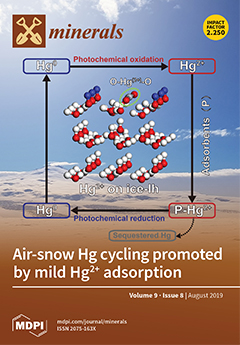The newly discovered Magushan Cu-Mo polymetallic deposit, located in southeastern Anhui, eastern China, is a middle-scale skarn-type polymetallic deposit with different ore types of veinlets-disseminated skarn (the primary type), quartz veins, and porphyry. LA-ICP-MS zircon U–Pb analyses yielded a crystallization age of 135.7
[...] Read more.
The newly discovered Magushan Cu-Mo polymetallic deposit, located in southeastern Anhui, eastern China, is a middle-scale skarn-type polymetallic deposit with different ore types of veinlets-disseminated skarn (the primary type), quartz veins, and porphyry. LA-ICP-MS zircon U–Pb analyses yielded a crystallization age of 135.7 ± 1.5 Ma for the ore-related granodiorite in Magushan. The granodiorites are I-type granites in nature, characterized by metaluminous and high-K calc-alkaline characteristics. They are enriched in large ion lithophile elements (LILEs, e.g., Ba, Th, and U) and light rare earth elements (LREEs), and depleted in high field strength elements (NFSEs, e.g., Nb, Ta, and Ti) and heavy rare earth element (HREEs), with slightly negative Eu anomalies (Eu/Eu* = 0.81–0.86). These granodiorites show high Mg# (mainly > 40) values, high MgO (1.73–1.96 wt. %) and low Na
2O (<4.21 wt. %) contents, with whole-rock (
87Sr/
86Sr)
i ratios (0.708877 to 0.710398), negative ε
Nd(t) values of −5.4 to −5.2, and negative zircon ε
Hf(t) values of −4.60 to −1.37, with old two-stage Hf model ages (T
DM2) between 1.2‒1.5 Ga. Besides, they are characterized by high radiogenic Pb isotopic compositions with (
206Pb/
204Pb)
i = 18.44–18.56, (
207Pb/
204Pb)
i = 15.66–15.67, and (
208Pb/
204Pb)
i = 38.77–38.87. These granodiorites are characterized by high zircon Ce
4+/Ce
3+ ratios (average 893) and Eu/Eu* ratios (average 0.51), indicating high magmatic oxygen fugacities. The distinct geochemical and isotopic features suggest that the Magushan granodiorites could be formed by metasomatized mantle-derived magmas, mixing with materials from Neoproterozoic crust that is widely distributed in the Southern Anhui. This study concludes that the formation of the Magushan Cu-Mo polymetallic deposits may largely depend on an oxidizing environment and multi-sources mixed of mantle- and crust-derived materials.
Full article





